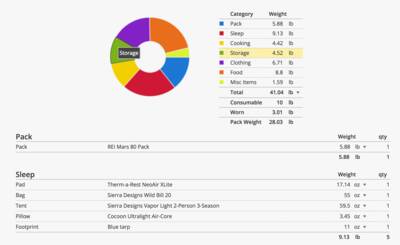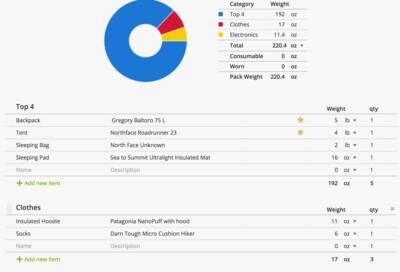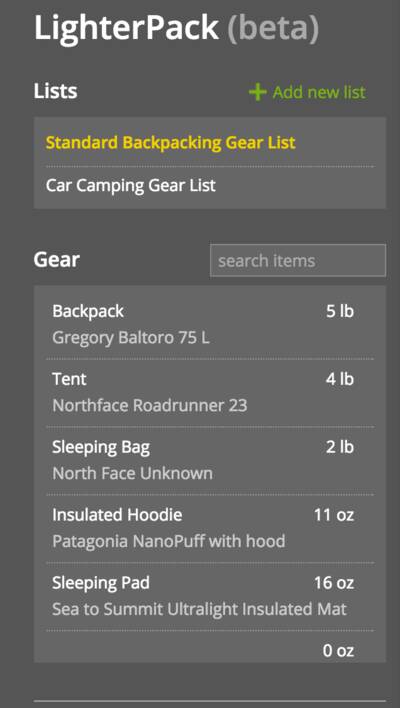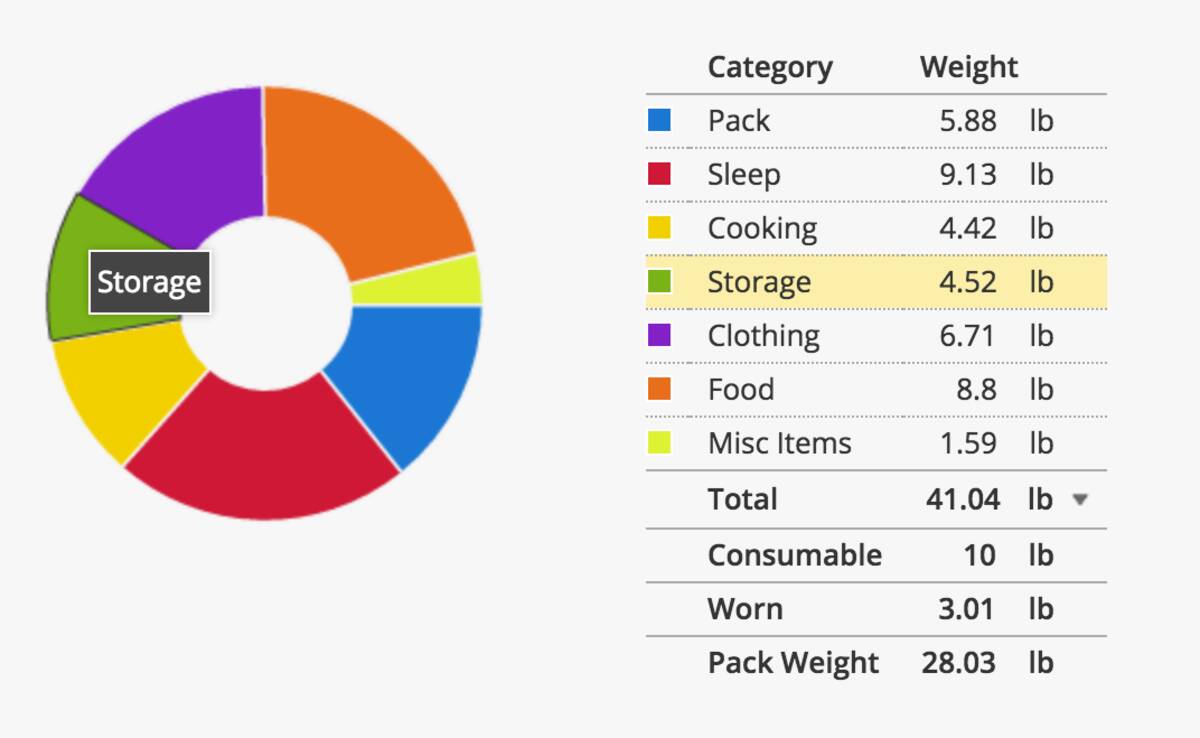Backpackers.com — Should I pack this? Should I leave it? The piles of clothes, the bins of gear, the Ziploc bags with spare batteries are spread out all over your floor. You're rummaging through in a methodical panic, trying to remember what you took on your last trip, what you'll need for this trip, how much that pair of gloves weighs, checking the weather on your smartphone, checking the expiration date on your bars, your gels, your…
This is the approach many have cultivated the night or week before a backpacking trip. Bring out all the gear, make sense of it. This may work for you, and it will certainly get you into the backcountry. But doing it like this will either mean you're ultra-prepared and have an overstuffed backpack, or you'll find you're missing some piece of kit you really meant to take.
There's a better way: LighterPack.
LighterPack
There are a number of software applications out there that will help you load the weight of your gear and establish a pack list more efficiently. Our favorite is LighterPack. Why? It's dead simple. It's free. It has easy color coordinating options and a very user friendly interface.

It's also one of the primary tools by the folks on the subreddit /r/Ultralight — and those cats are some die-hard lightweight junkies. This is a great thing because it means some of the most gear-oriented people out there use this application to get the job done. However, that doesn't mean in any way that LighterPack pressures one to go lightweight or ultralight in their setup.
Yes, putting everything in an application with assigned weight does tend to help lighten the load. That's part of the process. But LighterPack doesn't have a large judgement factor built in that shows you how you could get lighter, what items are not necessary, or any competing products at all.
How It Works
When you head to LighterPack you'll be greeted with an empty pie chart, the option to input an item in a row, and a summary screen on the left-hand side. You'll need to create an account, which will take an email, a username, and a password. There is no spam associated with LighterPack — the account is so you can log in and easily access the gear List you've been building, or multiple Lists.
Essentially you will input all of your gear into LighterPack, including weight and a number of other factors. This will result in a pie-chart and weight calculation that tells you how much weight you've included for certain areas of your pack.

We break down each function of LighterPack below.
Lists
Each individual set of gear is termed a “List.” You can name your List anything you want. This is helpful if you have an ultralight setup and a normal-load setup, or if you want to have two separate gear lists for car camping and backpacking. The same is true if you're a packrafter, a climber, a biker, or any multi-sport adventurer. Get all your lists in order without too much effort.
One of the great features about the multi-List capability is that every piece of gear you enter is added to the “Gear” section on the left-hand side. This is separate from the gear within a List. The “Gear” section on the left-hand side is all of the gear you have entered in your entire account.

You can easily drop and drag gear from multiple Lists without affecting any of the specific placement in the original List.
Categories
In the main section you'll see the pie-chart, individual items, and categories. Categories, like everything else here, can be named anything you want. Each category corresponds to a different color on the pie-chart, so break them up however you see fit.
One example:
- A category for your Top 4 Pieces of Necessary Gear: Shelter, Sleeping Bag, Backpack, Sleeping Pad.
- A category for clothing.
- A category for food.
- A category for electronics.
- A category for cooking.
This will cover the basic categories of the gear you need to bring, and as you enter each item you'll see your individual areas come together.

Categories are entirely up to you in terms of designation, so you could split them up however you'd like. This is a really great feature for those that are very specific about how they want to see their gear broken down in terms of weight and function.
Items
The “Items” are the actual pieces of gear you'll enter, one at a time. Each item has:
- Name: You can name your item anything you want. Many people use name for what the item is basically, like “Sleeping Pad.”
- Description: Again, input anything you want, but many people use this for the actual model name and number.
- Weight: You can toggle weight between pounds, ounces, grams and kilograms.
- Quantity: If you have multiples of one item, you don't have to enter it twice.

There's one more section for each item that is pretty powerful. LighterPack lets you click between 5 icons for each item, and each item can click more than one of these five icons. The icons are:
- Photo: This allows you to upload a photo of your item.
- Link: This allows you to hyperlink your item so you can see the official product page.
- Worn: This tells the calculator that you wear this item during your hike, versus in your pack.
- Consumable: This tells the calculator that something is edible, and therefore will lessen over time.
- Star: This allows you to star any item.
These differentials are great because they add a lot of depth to each item, but it also changes the overall calculation. Part of the point of LighterPack is to see how much your total Pack Weight is, versus your Total Weight. This difference is about what you're literally carrying on your back, versus how much your entire setup weighs, including your clothes and shoes during your hike.
You just have to tag your items correctly for this to work.
Sharable
Many people use LighterPack to further asses their gear, make adjustments, and reduce weight. It also serves as an excellent, easily accessible and update-able list of all your gear for future trips. This means that instead of scrambling on the floor for all your items, you will know which ones you need before you even start.
The other massive benefit of LighterPack is how shareable it is. You can export any list you have to an Excel sheet, which takes out the fancy UI and puts all of your information into a spreadsheet.
You can also share the URL with anyone so they can see what's in your pack. This is perfect if you're coordinating with a large or disparate group and want to see who has what, or if you want a community's opinion on what you should get rid of or keep in a backpack setup.
Finally, you can actually import a CSV file to LigherPack if you've been keeping a spreadsheet of your gear up until now.
Overall
LigherPack makes the process of listing your gear very simple. It's a tool, just like the gear you're inputting. One of our favorite things to do is make a Backpacking Dream List using all the gear we wish we had, and filling it in over time.
If you care at all about the amount of weight you're carrying into the backcountry, you'll want to check out LighterPack. It's simple, clutter free, and will give you a clear indication of what you're carrying.
All screenshots via Backpackers courtesy LighterPack. Note, not all gear is accurate or complete, but was created for the purpose of this article.

Hi , Thanks for this.
Wayne
Hi Wayne,
You’re welcome! We love this tool 🙂
Hi! I am not able to use the link URL with Lighter Pack. I copy the URL adress, paste it, but when I click after on the item linked, it does nothing. Can you help me with this problem.
Guylaine
Hi Guylaine,
Thanks for reading! We checked out the feature and it looks like in your normal edit screen, where you can add/edit items, you can paste a URL to a specific item by clicking the small chain link button.
However, you can’t “view” the item in the edit screen. Try clicking “share this list”, then opening the URL it provides. This will give you a public-facing version of your list (which isn’t editable), and in there you can click the link and it takes you to the item.
Does this help? If not let us know with more detail what the issue is. Thanks!